Influence of Hydrogen Enrichment Strategy on Performance Characteristics, Combustion and Emissions of a Rotary Engine for Unmanned Aerial Vehicles (UAVs)
Abstract
1. Introduction
2. Materials and Methods
2.1. CFD Model Geometry
2.2. Boundary and Initial Conditions
2.3. Modelling Procedure
2.4. Mesh Independency and CFD Model Validation
3. Results and Discussion
3.1. Combustion Analysis
3.2. Engine Performance
3.3. Emissions
3.4. Discussion
4. Conclusions
- The significant properties of hydrogen such as high homogeneity and diffusivity, fast flame propagation and large flammability enable hydrogen blended mixtures to have a more stable and complete combustion process. Moreover, increasing the concentration of O, H and OH radicals during the combustion process after the hydrogen addition increases combustion velocity and shortens combustion durations. Hence, heat losses during the combustion process can be reduced. In addition, pressure, temperature and HRR values in the working chamber are higher and the peak values of these parameters are obtained earlier and are closer to the TDC in hydrogen-blended cases compared to the neat gasoline-fueled case. Additionally, hydrogen-blended mixture flames can be propagated into the narrower gaps by the low quenching distance of hydrogen. Despite the geometric limitations of Wankel engines, it can be concluded that the hydrogen enrichment technique is quite advantageous for Wankel engines in terms of combustion performance.
- The quenching phenomenon of Wankel engines, which leads to higher squish flow due to the rotor housing interface, can be minimized with the hydrogen enrichment approach. Because increasing the burning speed with hydrogen addition contributes to obtaining a stronger squish flow. Thus, the performance characteristics of the Wankel engine increase with hydrogen enrichment. For a fixed ignition timing, IMEP, indicated torque and indicated power improved, despite the decrease in total fuel consumption of the hydrogen blended cases with the amount of hydrogen added. If the ignition timings are optimized based on the new ignition delay periods, it is feasible to enhance the engine performance of fuel mixtures.
- As the hydrogen content of the mixture increases, engine instability and soot, CO and CO2 emissions are reduced. The main reason for this is the increasing working chamber pressure and temperature with hydrogen addition. On the other hand, thermal NOx formation is also increased due to the higher operating temperature of the hydrogen-enriched cases.
5. Future Work
Author Contributions
Funding
Data Availability Statement
Acknowledgments
Conflicts of Interest
Nomenclature
| Stoichiometric air-to-fuel ratio of iso-octane | |
| Stoichiometric air-to-fuel ratio of hydrogen | |
| CA | Eccentric shaft angle |
| CA 10 | Eccentric shaft angle where the fuel mass burning rate reached 10% (°EA) |
| CA 50 | Eccentric shaft angle where the fuel mass burning rate reached 50% (°EA) |
| CA 10-90 | Eccentric shaft angle duration from 10% to 90% mass burning rate of the total fuel (°EA) |
| HRR | Heat release rate (J/°EA) |
| IMEP | Indicated mean effective pressure (bar) |
| rpm | Rotation per minutes |
| TDC | Top dead center |
| Excess air ratio | |
| and | Molar coefficients of and |
| and | Mass fractions of and |
References
- Cihan, O.; Doğan, H.E.; Kutlar, O.A.; Demirci, A.; Javadzadehkalkhoran, M. Evaluation of heat release and combustion analysis in spark ignition Wankel and reciprocating engine. Fuel 2020, 261, 116479. [Google Scholar] [CrossRef]
- Ji, C.; Wang, H.; Shi, C.; Wang, S.; Yang, J. Multi-objective optimization of operating parameters for a gasoline Wankel rotary engine by hydrogen enrichment. Energy Convers. Manag. 2021, 229, 113732. [Google Scholar] [CrossRef]
- Meng, H.; Ji, C.; Wang, S.; Wang, D.; Yang, J. Optimizing the idle performance of an n-butanol fueled Wankel rotary engine by hydrogen addition. Fuel 2021, 288, 119614. [Google Scholar] [CrossRef]
- Pillai, K.M.; Mithran, A.J.; Grips, V.K.W.; Kumar, K.; Sinha, U.K.; Varadarajan, M.N.; Isaac, J.J.; Murthy, Y.V.S. Design and Development of an Indigenous 55 Hp Wankel Engine. In Proceedings of the International Conference on Aerospace Science and Technology, Bangalore, India, 26–28 June 2008. [Google Scholar]
- Kweon, C.M. A Review of Heavy-Fueled Rotary Engine Combustion Technologies; Technical Report, ARL-TR-5546; Army Research Laboratory: Aberdeen Proving Ground, MD, USA, 2011; Available online: https://apps.dtic.mil/sti/pdfs/ADA545309.pdf (accessed on 5 December 2022).
- Tartakovsky, L.; Baibikov, V.; Gutman, M.; Veinblat, M.; Reif, J. Simulation of Wankel Engine Performance Using Commercial Software for Piston Engines; SAE Technical Paper; SAE: Warrendale, PA, USA, 2012. [Google Scholar] [CrossRef]
- Pisnoy, S.; Tartakovsky, L. Numerical Investigation of the combined influence of three-plug arrangement and slot positioning on Wankel engine performance. Energies 2021, 14, 1130. [Google Scholar] [CrossRef]
- Leboeuf, M.; Dufault, J.F.; Nickerson, M.; Becker, K. Performance of a Low-Blowby Sealing System for a High Efficiency Rotary Engine; SAE Technical Paper; SAE: Warrendale, PA, USA, 2018. [Google Scholar] [CrossRef]
- Kutlar, O.A.; Malkaz, F. Two-stroke Wankel type rotary engine: A new approach for higher power density. Energies 2019, 12, 4096. [Google Scholar] [CrossRef]
- Finkelberg, L.; Kostuchenkov, A.; Zelentsov, A.; Minin, V. Improvement of combustion process of spark-ignited aviation Wankel engine. Energies 2019, 12, 2292. [Google Scholar] [CrossRef]
- Boughou, S.; Mohiuddin, A.K.M. Combustion chamber design effect on the rotary engine performance- A review. Int. J. Automot. Eng. 2020, 11, 200–212. [Google Scholar] [CrossRef]
- Zhang, Y.; Zuo, Z.; Liu, J.; Stewart, P.; Bingham, C. Numerical analysis on combustion characteristic of leaf spring rotary engine. Energies 2015, 8, 8086–8109. [Google Scholar] [CrossRef]
- Su, T.; Ji, C.; Wang, S.; Shi, L.; Yang, J.; Cong, X. Effect of spark timing on performance of a hydrogen-gasoline rotary engine. Energy Convers. Manag. 2017, 148, 120–127. [Google Scholar] [CrossRef]
- Amrouche, F.; Erickson, P.A.; Park, J.W.; Varnhagen, S. Extending the lean operation limit of a gasoline Wankel rotary engine using hydrogen enrichment. Int. J. Hydrogen Energy 2016, 41, 14261–14271. [Google Scholar] [CrossRef]
- Amrouche, F.; Erickson, P.A.; Park, J.W.; Varnhagen, S. An experimental study of a hydrogen-enriched ethanol fueled Wankel rotary engine at ultra lean and full load conditions. Energy Convers. Manag. 2016, 123, 174–184. [Google Scholar] [CrossRef]
- Fan, B.; Pan, J.; Yang., W.; Liu., Y.; Bani, S.; Chen, W. Numerical investigation of the effect of injection strategy on mixture formation and combustion process in a port injection natural gas rotary engine. Energy Convers. Manag. 2017, 123, 511–523. [Google Scholar] [CrossRef]
- Su, T.; Ji, C.; Wang, S.; Cong, X.; Shi, L.; Yang, J. Improving the lean performance of an n-butanol rotary engine by hydrogen enrichment. Energy Convers. Manag. 2018, 157, 96–102. [Google Scholar] [CrossRef]
- Fan, B.; Pan, J.; Yang, W.; Chen, W.; Bani, S. The influence of injection strategy on mixture formation and combustion process in a direct injection natural gas rotary engine. Appl. Energy 2017, 187, 663–674. [Google Scholar] [CrossRef]
- Ji, C.; Chang, J.; Wang, S.; Yang, J.; Wang, D.; Cheng, S.; Ma, Z.; Zhang, B. Numerical study of hydrogen direct injection strategy on mixture formation and combustion process in a partially premixed gasoline Wankel rotary engine. Energy Convers. Manag. 2018, 176, 184–193. [Google Scholar] [CrossRef]
- Fan, B.W.; Pan, J.F.; Pan, Z.H.; Tang, A.K.; Zhu, Y.J.; Xue, H. Effects of pocket shape and ignition slot locations on the combustion processes of a rotary engine fueled with natural gas. Appl. Therm. Eng. 2015, 89, 11–27. [Google Scholar] [CrossRef]
- Yang, J.; Ji, C.; Wang, S.; Wang, D.; Ma, Z.; Ma, L. A comparative study of mixture formation and combustion processes in a gasoline Wankel rotary engine with hydrogen port and direct injection enrichment. Energy Convers. Manag. 2018, 168, 21–31. [Google Scholar] [CrossRef]
- Ohkubo, M.; Tashima, S.; Shimizu, R.; Fuse, S.; Ebino, H. Developed Technologies of the New Rotary Engine (RENESIS); SAE Technical Paper; SAE: Warrendale, PA, USA, 2004. [Google Scholar] [CrossRef]
- Taskiran, O.O. Improving burning speed by using hydrogen enrichment and turbulent jet ignition system in a rotary engine. Int. J. Hydrogen Energy 2021, 46, 29649–29662. [Google Scholar] [CrossRef]
- Dhole, A.E.; Yarasu, R.B.; Lata, D.B.; Priyam, A. Effect on performance and emissions of a dual fuel diesel engine using hydrogen and producer gas as secondary fuels. Int. J. Hydrogen Energy 2014, 39, 8087–8097. [Google Scholar] [CrossRef]
- Dhole, A.E.; Yarasu, R.B.; Lata, D.B. Effect of hydrogen and producer gas as secondary fuels on combustion parameters of a dual fuel diesel engine. Appl. Therm. Eng. 2016, 108, 764–773. [Google Scholar] [CrossRef]
- Wang, J.; Huang, Z.; Tang, C.; Zheng, J. Effect of hydrogen addition on early flame growth of lean burn natural gas-air mixture. Int. J. Hydrogen Energy 2010, 35, 7246–7252. [Google Scholar] [CrossRef]
- Wang, J.; Huang, Z.; Zheng, J.; Miao, H. Effect of partially premixed and hydrogen addition on natural gas direct-injection lean combustion. Int. J. Hydrogen Energy 2009, 34, 9239–9247. [Google Scholar] [CrossRef]
- Di Sarli, V.; Di Benedetto, A.; Long, E.J.; Hargrave, G.K. Time-Resolved Particle Image Velocimetry of dynamic interactions between hydrogen-enriched methane/air premixed flames and toroidal vortex structures. Int. J. Hydrogen Energy 2012, 37, 16201–16213. [Google Scholar] [CrossRef]
- Hu, E.; Huang, Z.; Zheng, J.; Li, Q.; He, J. Numerical study on laminar burning velocity and NO formation of premixed methane-hydrogen-air flames. Int. J. Hydrogen Energy 2009, 34, 6545–6557. [Google Scholar] [CrossRef]
- Agreda, A.; Di Sarli, V.; Di Benedetto, A. Bifurcation analysis of the effect of hydrogen addition on the dynamic behavior of lean premixed pre-vaporized ethanol combustion. Int. J. Hydrogen Energy 2012, 37, 6922–6932. [Google Scholar] [CrossRef]
- Di Sarli, V. Stability and emissions of a lean pre-mixed combustor with rich catalytic/lean-burn pilot. Int. J. Chem. React. Eng. 2014, 12, 77–89. [Google Scholar] [CrossRef]
- Salzano, E.; Cammarota, F.; Di Benedetto, A.; Di Sarli, V. Explosion behavior of hydrogen-methane/air mixtures. J. Loss Prev. Process Ind. 2012, 25, 443–447. [Google Scholar] [CrossRef]
- Cammarota, F.; Di Benedetto, A.; Di Sarli, V.; Salzano, E. The effect of hydrogen addition on the explosion of ethanol/air mixtures. Chem. Eng. Trans. 2012, 26, 405–410. [Google Scholar] [CrossRef]
- Wang, H.; Ji, C.; Shi, C.; Wang, S.; Yang, J.; Ge, Y. Investigation of the gas injection rate shape on combustion, knock and emissions behavior of a rotary engine with hydrogen direct-injection enrichment. Int. J. Hydrogen Energy 2021, 46, 14790–14804. [Google Scholar] [CrossRef]
- Fan, B.; Pan, J.; Liu, Y.; Zhu, Y.; Pan, Z.; Chen, W.; Otchere, P. Effect of hydrogen injection strategies on mixture formation and combustion process in a hydrogen direct injection plus natural gas port injection rotary engine. Energy Convers. Manag. 2018, 160, 150–164. [Google Scholar] [CrossRef]
- Ji, C.; Su, T.; Wang, S.; Zhang, B.; Yu, M.; Cong, X. Effect of hydrogen addition on combustion and emissions performance of a gasoline rotary engine at part load and stoichiometric conditions. Energy Convers. Manag. 2016, 121, 272–280. [Google Scholar] [CrossRef]
- Ji, C.; Chang, K.; Wang, S.; Yang, J.; Wang, D.; Meng, H.; Wang, H. Effect of injection strategy on the mixture formation and combustion process in a gasoline direct injection rotary engine. Fuel 2021, 304, 121428. [Google Scholar] [CrossRef]
- Shi, C.; Ji, C.; Wang, S.; Jinxin, Y.; Huaiyu, W. Experimental and numerical study of combustion and emissions performance in a hydrogen-enriched Wankel engine at stoichiometric and lean operations. Fuel 2021, 291, 120181. [Google Scholar] [CrossRef]
- Zambalov, S.D.; Yakovlev, I.A.; Skripnyak, V.A. Numerical simulation of hydrogen combustion process in rotary engine with laser ignition system. Int. J. Hydrogen Energy 2017, 42, 17251–17259. [Google Scholar] [CrossRef]
- Spreitzer, J.; Zahradnik, F.; Geringer, B. Implementation of a Rotary Engine (Wankel Engine) in a CFD Simulation Tool with Special Emphasis on Combustion and Flow Phenomena; SAE Technical Papers; SAE: Warrendale, PA, USA, 2015. [Google Scholar] [CrossRef]
- Wang, S.; Ji, C.; Zhang, B. Effects of hydrogen addition and cylinder cutoff on combustion and emissions performance of a spark-ignited gasoline engine under a low operating condition. Energy 2010, 35, 4754–4760. [Google Scholar] [CrossRef]
- Richards, K.J.; Senecal, P.K.; Pomraning, E. Converge Manual 3.0; Convergent Science: Madison, WI, USA, 2022. [Google Scholar]
- Issa, R.I. Solution of the implicitly discretised fluid flow equations by operator-splitting. J. Comput. Phys. 1986, 62, 40–65. [Google Scholar] [CrossRef]
- Sener, R.; Yangaz, M.U.; Gul, M.Z. Effects of injection strategy and combustion chamber modification on a single-cylinder diesel engine. Fuel 2020, 266, 117122. [Google Scholar] [CrossRef]
- Boretti, A. Modeling Unmanned Aerial Vehicle Jet Ignition Wankel Engines with CAE/CFD. Adv. Aircr. Spacecr. Sci. 2015, 2, 445–467. [Google Scholar] [CrossRef]
- Sener, R.; Gül, M.Z. Optimization of the combustion chamber geometry and injection parameters on a light-duty diesel engine for emission minimization using multi-objective genetic algorithm. Fuel 2021, 304, 121379. [Google Scholar] [CrossRef]
- Senecal, P.K.; Pomraning, E.; Richards, K.J.; Briggs, T.E.; Choi, C.Y.; McDavid, R.M. Multi-Dimensional Modeling of Direct-Injection Diesel Spray Liquid Length and Flame Lift-off Length Using CFD and Parallel Detailed Chemistry; SAE Technical Paper; SAE: Warrendale, PA, USA, 2003. [Google Scholar] [CrossRef]
- Jia, M.; Xie, M.A. Chemical kinetics model of iso-octane oxidation for HCCI engines. Fuel 2006, 85, 2593–2604. [Google Scholar] [CrossRef]
- Bigalli, S.; Catalani, I.; Balduzzi, F.; Matteazzi, N.; Agostinelli, L.; De Luca, M.; Ferrara, G. Numerical investigation on the performance of a 4-stroke engine with different passive pre-chamber geometries using a detailed chemistry solver. Energies 2022, 15, 4968. [Google Scholar] [CrossRef]
- Kan, Z.; Hu, Z.; Lou, D.; Cao, Z.; Cao, J. Effect of the altitude on the combustion characteristics of a low-compression-ratio diesel engine during the start-up process. Proc. Inst. Mech. Eng. Part D J. Automob. Eng. 2017, 231, 1838–1847. [Google Scholar] [CrossRef]
- Heywood, J.B. Internal Combustion Engine Fundamentals; McGraw-Hill: New York, NY, USA, 1988. [Google Scholar]
- Norbye, J.P. Wankel Rotary Engine; Chilton Book Company: Philadelphia, PA, USA, 1971. [Google Scholar]
- Huang, Z.; Zhang., Y.; Zeng, K.; Liu, B.; Wang, Q.; Jiang, D. Measurements of laminar burning velocities for natural gas-hydrogen-air mixtures. Combust Flame 2006, 146, 302–311. [Google Scholar] [CrossRef]
- Singh, S.; Musculus, M.P.B.; Reitz, R.D. Mixing and flame structures inferred from OH-PLIF for conventional and low temperature diesel engine combustion. Combust. Flame 2009, 156, 1898–1908. [Google Scholar] [CrossRef]
- Zhu, H.; Duan, J. Research on emission characteristics of hydrogen fuel internal combustion engine based on more detailed mechanism. Int. J. Hydrogen Energy 2019, 44, 5592–5598. [Google Scholar] [CrossRef]
- Su, T.; Ji, C.; Wang, S.; Shi, L.; Yang, J.; Cong, X. Idle performance of a hydrogen/gasoline rotary engine at lean condition. Int. J. Hydrogen Energy 2017, 42, 12696–12705. [Google Scholar] [CrossRef]
- Su, T.; Ji, C.; Wang, S.; Shi, L.; Yang, J.; Cong, X. Improving idle performance of hydrogen-gasoline rotary engine at stoichiometric condition. Int. J. Hydrogen Energy 2017, 42, 11893–11901. [Google Scholar] [CrossRef]
- Li, A.; Zheng, Z.; Peng, T. Effect of Water Injection Timing on the Combustion and Emissions of a Direct Injection Gasoline Engine. Energy Technol. J. 2021, 9, 2001064. [Google Scholar] [CrossRef]
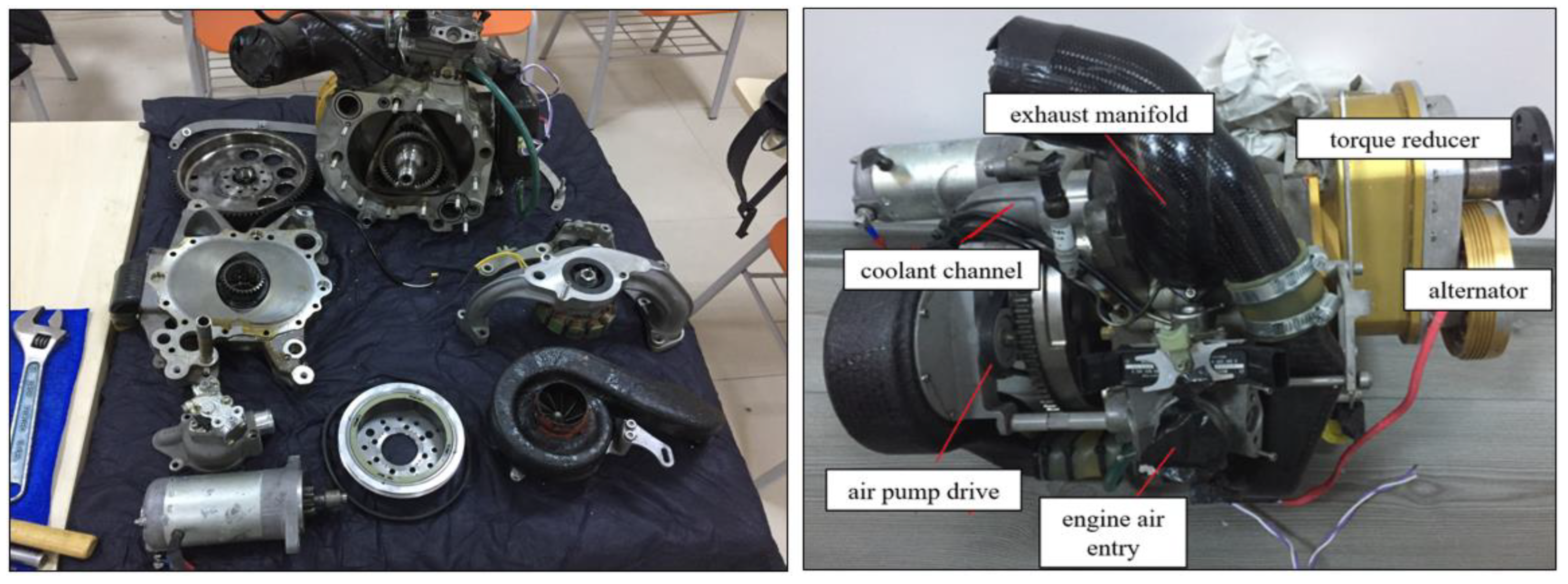
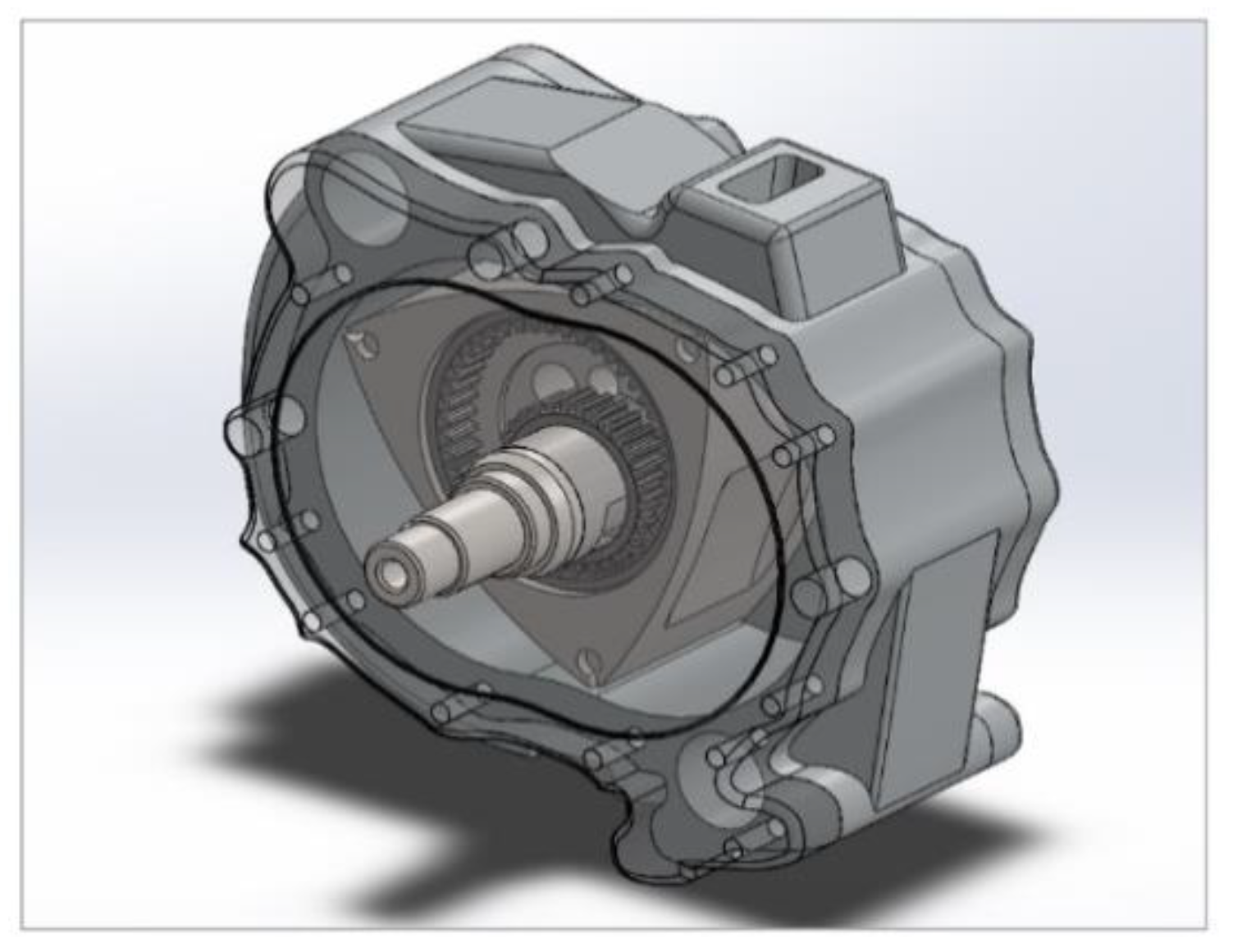
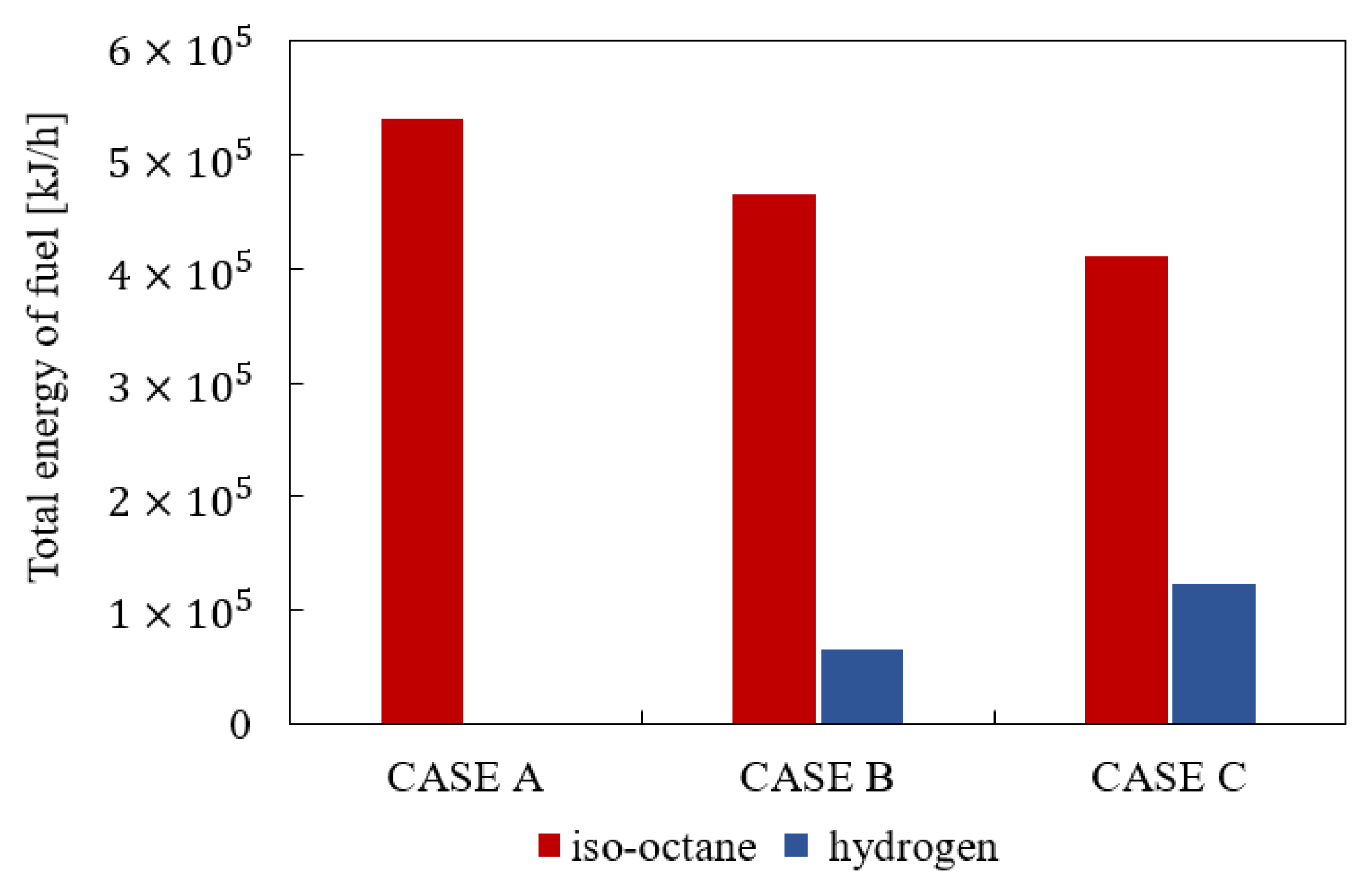

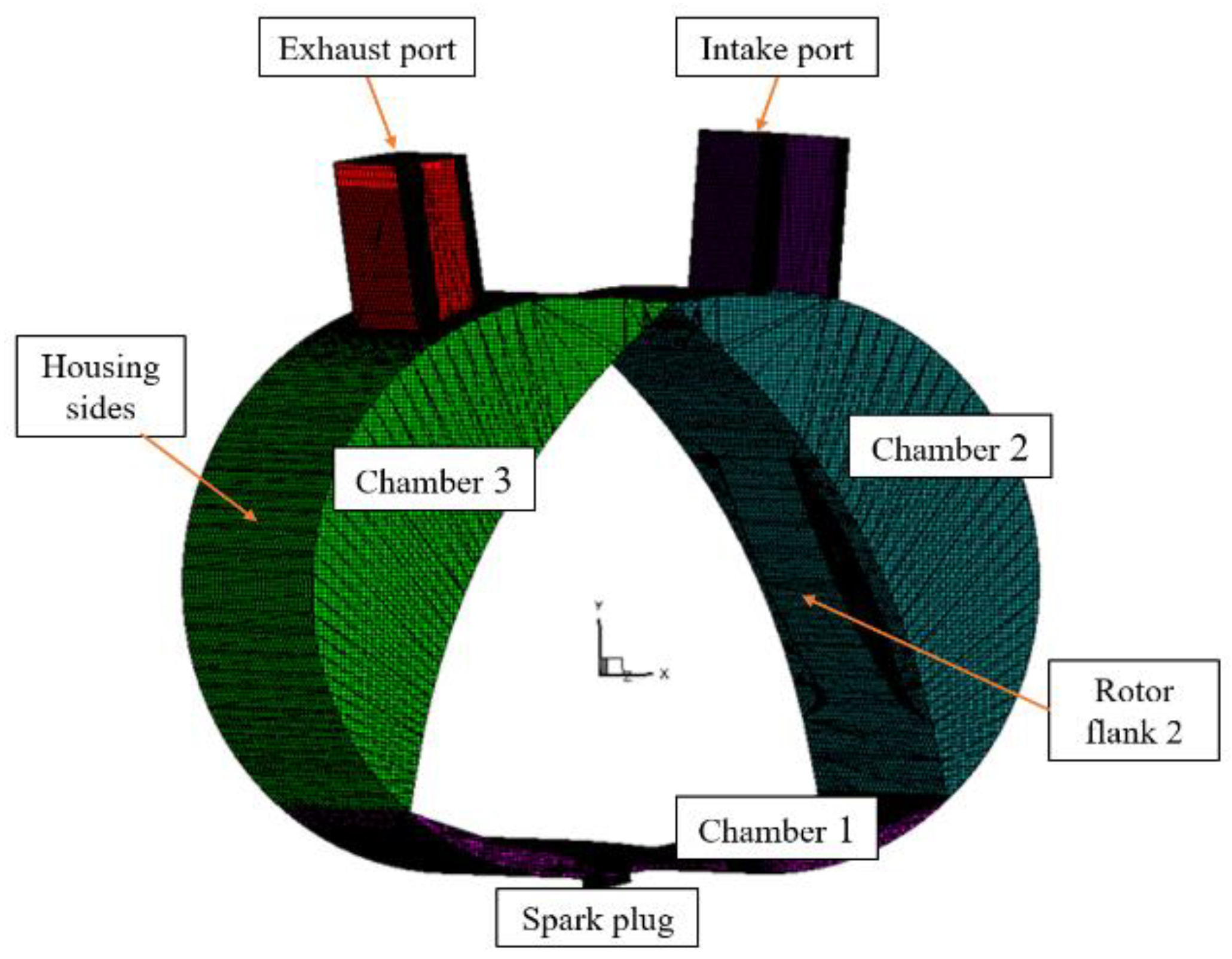
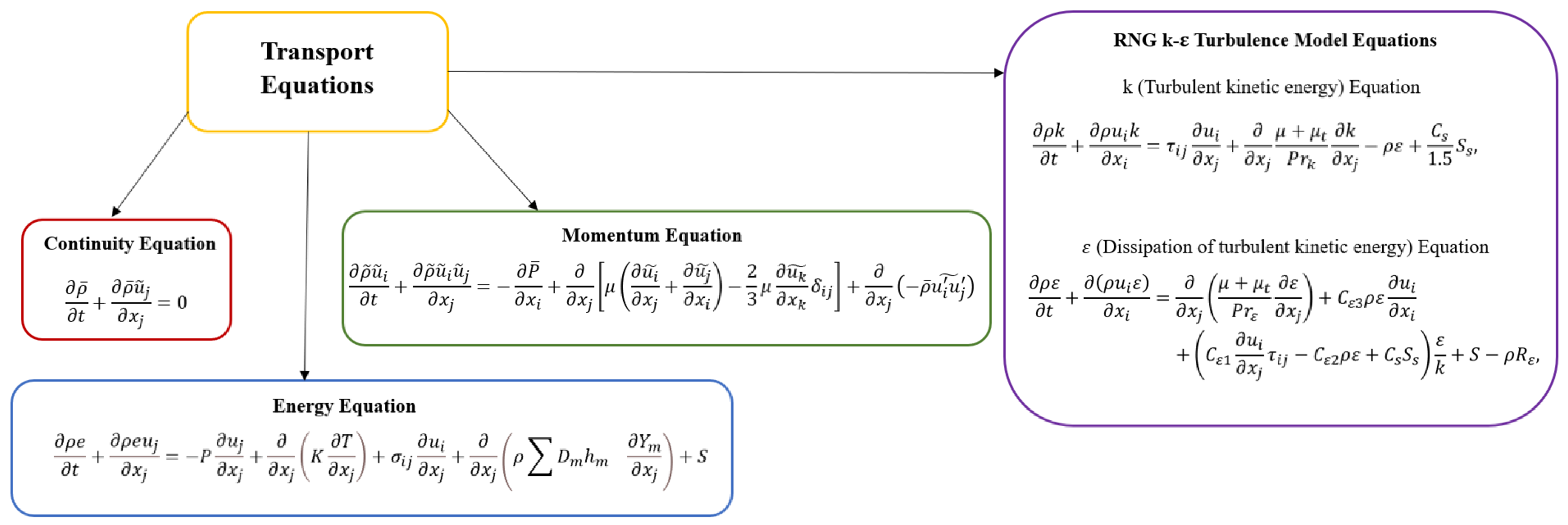


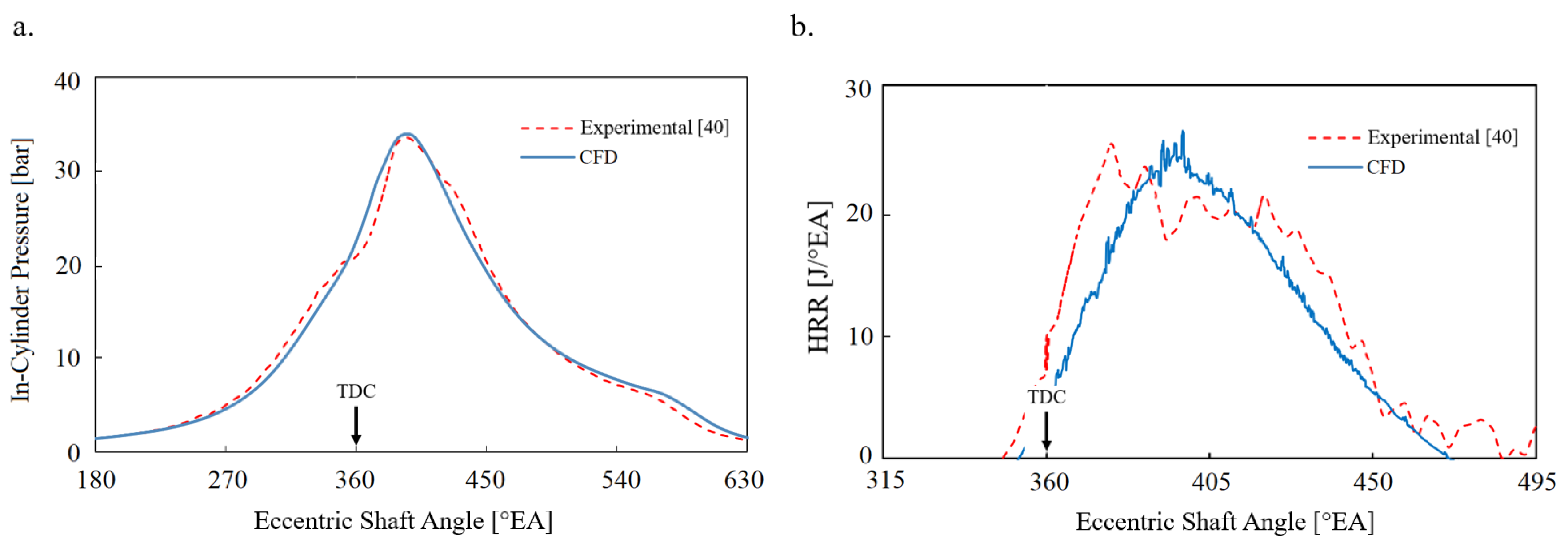
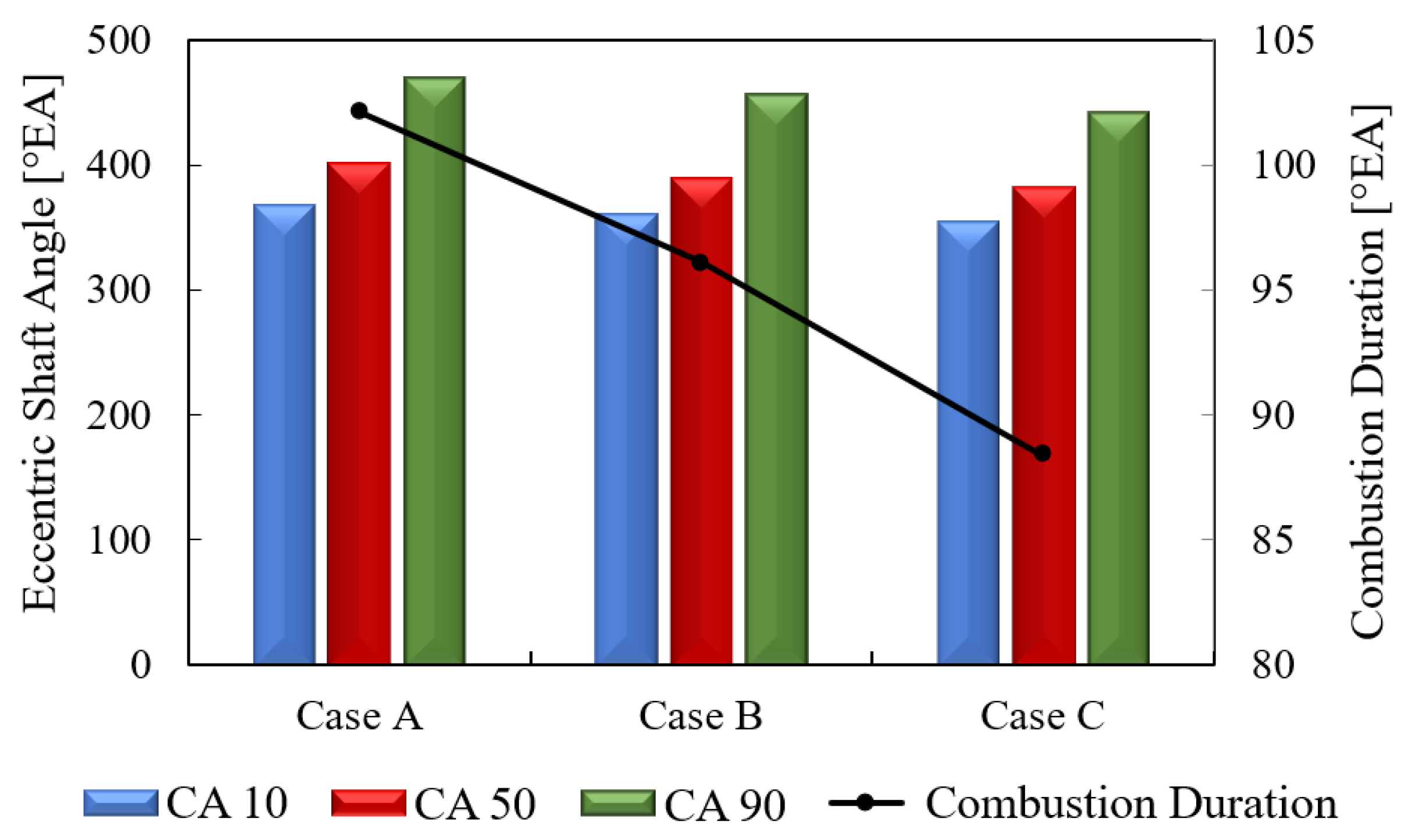


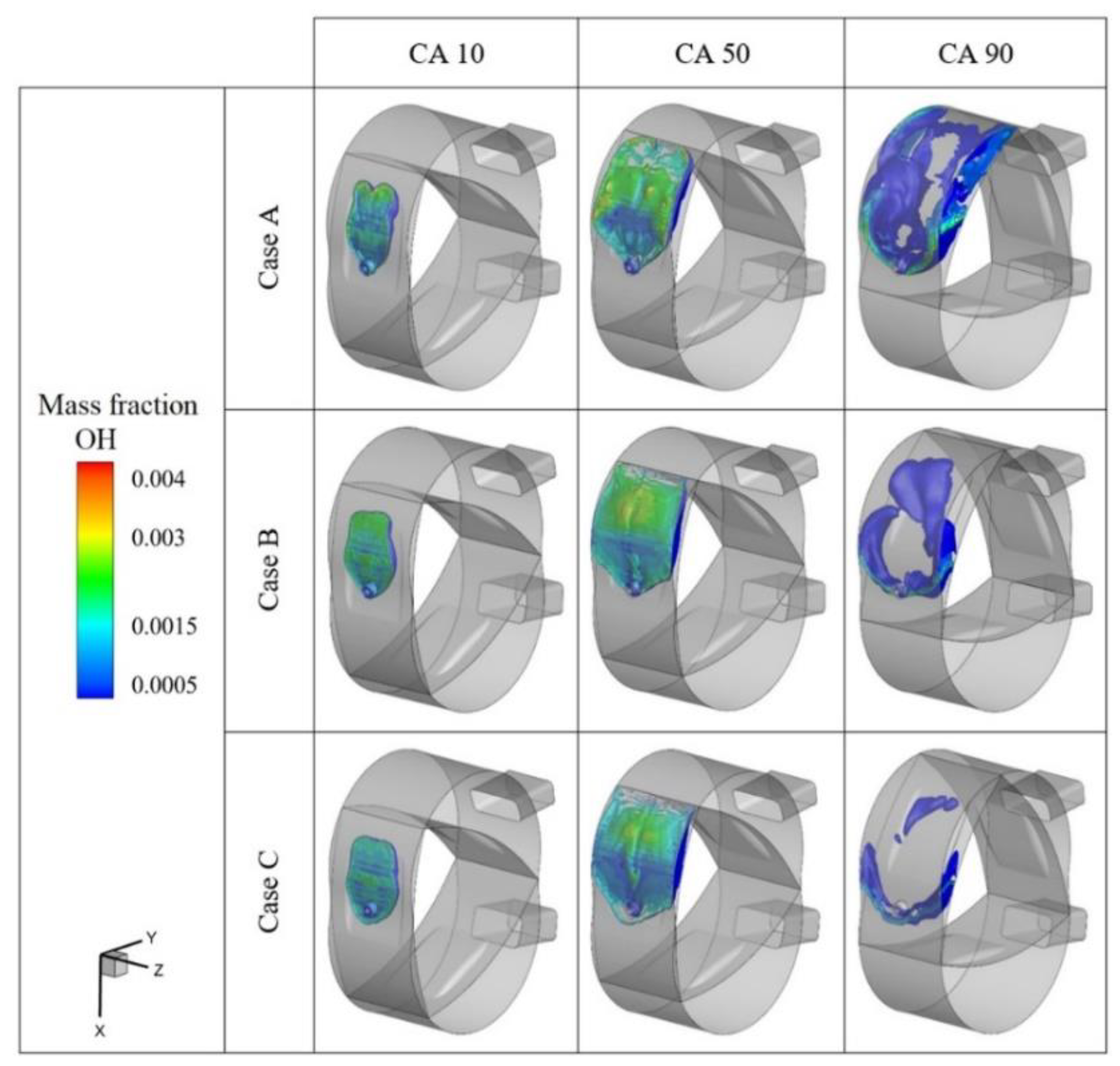
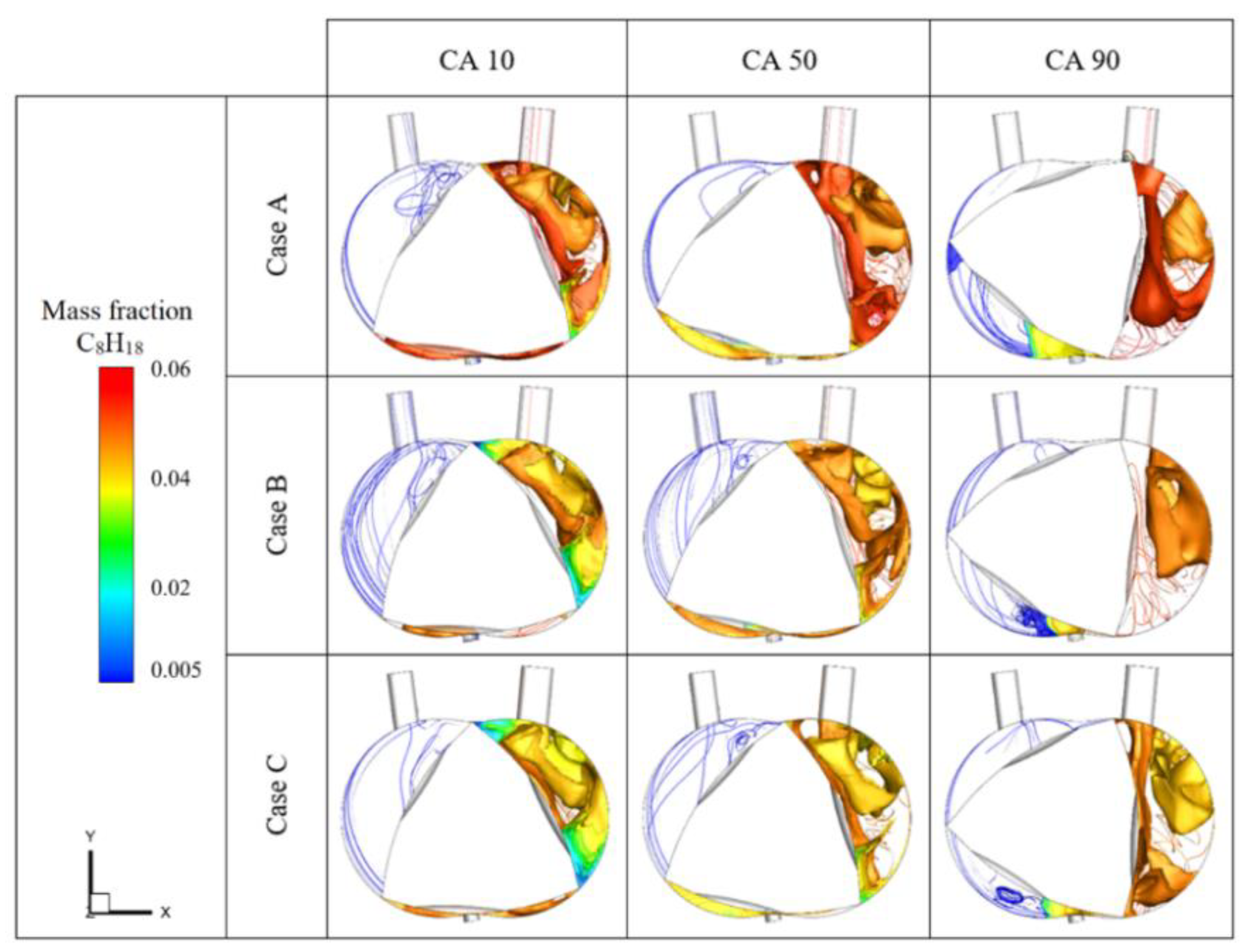

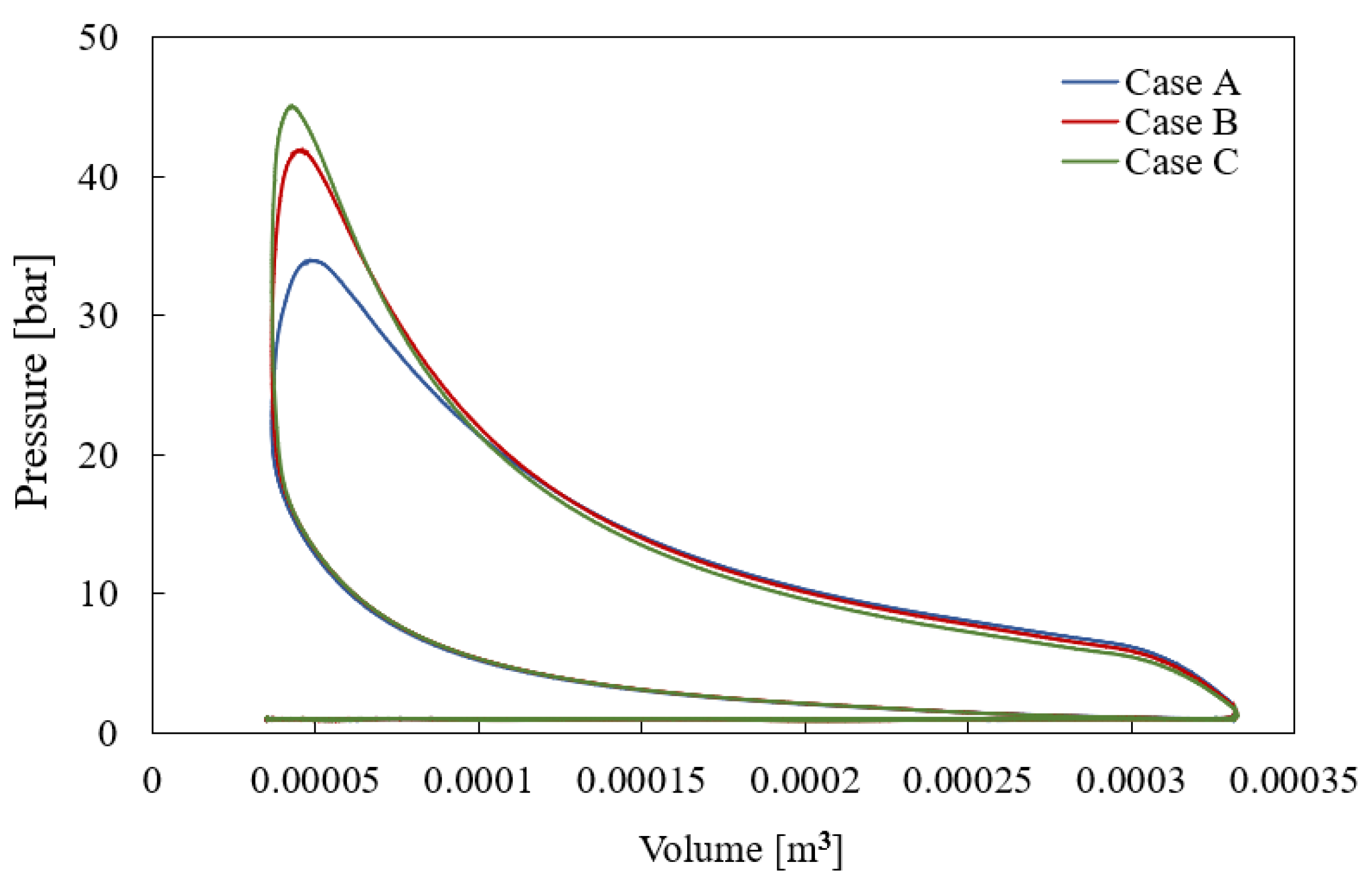


| Engine Type | A Single-Rotor, Four-Stroke Wankel Engine |
|---|---|
| Radius, (R) [mm] | 71.89 |
| Amount of parallel transfer of trochoid, (a) [mm] | 1.05 |
| Generating Radius, () | 72.94 |
| Eccentricity, (e) [mm] | 11.5 |
| Width [mm] | 7.44 |
| k-factor (k) | 6.34 |
| Inlet | In the trochoid |
| Outlet | In the trochoid |
| Power output | 35 [kW] @ 6000 rpm |
| Spark plug position | 10 mm after the minor axis |
| Spark plug shape/radius [mm] | Sphere/1 |
| Bearing | Ball bearing |
| Rotor cooling and lubrication | Air/oil mixture |
| Housing cooling | Water |
| Subject | Input |
|---|---|
| Compression ratio | 9.6 |
| Spark plugs energy | 0.03 and 0.04 J |
| Spark plugs surface temperature | 625 K |
| Inlet air conditions | Sea level conditions |
| Intake and exhaust port | Pressures boundary condition |
| Intake/exhaust port surface temperature | 323/500 K |
| Rotor/house wall temperature | 488/443 K |
| Rotor wall | Wall boundary condition |
| Wall boundary | No-slip |
| Pressure–Velocity coupling | PISO algorithm |
| Reaction mechanism | 48 species and 152 reactions |
| Mesh method | Modified cut-cell Cartesian |
| Mass Flow Rates of the Fuels in the Mixture | Mass Fractions of the Fuels in the Mixture | |||
|---|---|---|---|---|
| Case A | 11.88 | 0.00 | 0.0623 | 0.0000 |
| Case B | 10.42 | 0.55 | 0.0592 | 0.0031 |
| Case C | 9.18 | 1.02 | 0.0560 | 0.0063 |
| Subject | Input |
|---|---|
| Turbulent model | RNG k-ε |
| Wall model | Wall heat transfer: O’Rourke and Amsden |
| Near wall treatment: Standard Wall Function | |
| Combustion model | SAGE (Adaptive Zoning) |
| NOx model | Extended Zeldovich |
| Soot model | Hiroyasu-NSC |
Publisher’s Note: MDPI stays neutral with regard to jurisdictional claims in published maps and institutional affiliations. |
© 2022 by the authors. Licensee MDPI, Basel, Switzerland. This article is an open access article distributed under the terms and conditions of the Creative Commons Attribution (CC BY) license (https://creativecommons.org/licenses/by/4.0/).
Share and Cite
Kucuk, M.; Surmen, A.; Sener, R. Influence of Hydrogen Enrichment Strategy on Performance Characteristics, Combustion and Emissions of a Rotary Engine for Unmanned Aerial Vehicles (UAVs). Energies 2022, 15, 9331. https://doi.org/10.3390/en15249331
Kucuk M, Surmen A, Sener R. Influence of Hydrogen Enrichment Strategy on Performance Characteristics, Combustion and Emissions of a Rotary Engine for Unmanned Aerial Vehicles (UAVs). Energies. 2022; 15(24):9331. https://doi.org/10.3390/en15249331
Chicago/Turabian StyleKucuk, Merve, Ali Surmen, and Ramazan Sener. 2022. "Influence of Hydrogen Enrichment Strategy on Performance Characteristics, Combustion and Emissions of a Rotary Engine for Unmanned Aerial Vehicles (UAVs)" Energies 15, no. 24: 9331. https://doi.org/10.3390/en15249331
APA StyleKucuk, M., Surmen, A., & Sener, R. (2022). Influence of Hydrogen Enrichment Strategy on Performance Characteristics, Combustion and Emissions of a Rotary Engine for Unmanned Aerial Vehicles (UAVs). Energies, 15(24), 9331. https://doi.org/10.3390/en15249331









